Timing chain problems
Timing chain problems—what are the symptoms?
Timing chain problems can appear as noise or engine performance issue, or both. Whether the symptom is noise or engine performance the root cause is always caused by the timing chain tensioner, guides or a worn and elongate chain. To understand how a timing chain can cause noise or performance issue, you first have to understand the job of a timing chain.
What does a timing do?
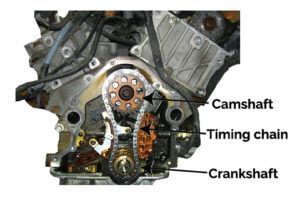
Timing chain installed on a V-style engine without overhead camshafts
A timing chain connects the engine crankshaft to the camshaft so they rotate in “time” with one another. In older engine designs without an overhead camshaft, the timing 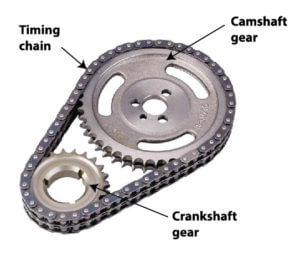 chain is short and doesn’t require a tensioner (see image). However, as carmakers began using overhead cam designs they were forced to incorporate much longer timing chains to span the distance between the crankshaft sprocket and the camshaft sprockets. To prevent the timing chain from rattling over that long distance, they incorporated plastic guides and sometimes even hydraulic tensioning devices to keep the chain at a constant tension.
chain is short and doesn’t require a tensioner (see image). However, as carmakers began using overhead cam designs they were forced to incorporate much longer timing chains to span the distance between the crankshaft sprocket and the camshaft sprockets. To prevent the timing chain from rattling over that long distance, they incorporated plastic guides and sometimes even hydraulic tensioning devices to keep the chain at a constant tension.
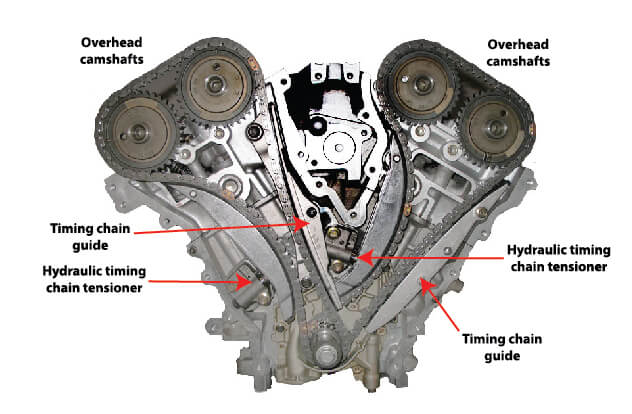
Notice the two timing chains, two hydraulic tensioners and chain guides
When new, the tensioner and guides work well to keep chain noise to a minimum. But if you don’t change your oil according to the carmakers schedule or use the wrong type or viscosity motor oil, timing chain problems can develop, such as timing chain stretch and even metal breakdown.
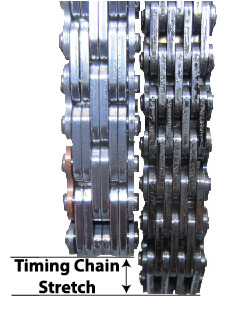
New and stretched timing chain
Timing chain problems
When an owner neglects oil changes or uses the wrong oil, the timing chain pins wear, causing the chain to stretch. Stretching, in turn, causes other problems.
Stretched timing chain symptoms
• Noise. Timing chain noise is most noticeable on cold startup when oil pressure and flow is at its lowest. The excess slack can cause a rattling sound or even a clanking sound if the slack is severe enough to cause the chain to slap against the timing chain cover. If the engine is equipped with a hydraulic timing chain tensioner, the noise may disappear or lessen as the engine oil warms up and the tensioner removes some of the slack. However, if the timing chain wear is great enough so that the tensioner can no longer compensate for the slack, the noise may continue even after warm up.
• Rough idle. Since the timing chain controls when the intake and exhaust valves open in relation to the pistons, a worn chain can cause the valves to be out of time, opening and closing slightly early or late. At idle speed, the result is a rough idle that causes the engine to shake when you’re at a stop.
• Check engine light. When the intake and exhaust valves are out of time with the crankshaft, they cause incomplete combustion that’s detected by the engine control computer and reported as a misfire. In other words, valves that don’t open and close exactly when expected cause an incomplete burn, resulting in a reduced power contribution from each cylinder and excessive emissions. Those misfires and excessive emissions can then result in costly damage to the vehicle’s catalytic converter.
• Metallic debris in the oil. When a timing chain wears or the timing chain guides are damaged, metallic particles may be found in the drain oil.
What causes timing chain damage?
In almost all cases, timing chains stretch due to improper owner maintenance. Going too long between oil changes and using the wrong type or viscosity rated motor oil causes the timing chain pins and plates to wear, resulting in timing chain stretch. In addition to oil change neglect and improper oil usage, using the wrong or low quality oil filter can also cause accelerated timing chain wear.
Oil filters that are mounted on the side or top of the engine incorporate an anti-drainback valve that prevent oil in the filter from draining out when the engine is shut down. If the anti-drainback valve fails, it will result in a severe delay in oil flow at cold startup. That’s because the oil pump must completely refill the oil filter before it can provide lubrication to the rest of the engine.
How an oil filter can cause timing chain problems
Economy oil filters use a cheap nitrile rubber anti-drainback valve.
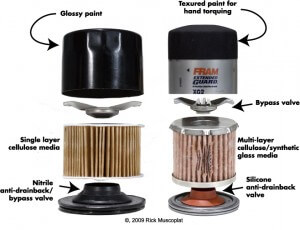
Economy oil filter with nitrile anti-drainback valve versuse a premium filter with a silicone anti-drainback valve
Those valve have an approximate useful life of around 3,000 miles. After that, the nitrile material begins to harden and develop heat related cracks. The hardened seal and cracks prevent the valve from doing its job and allows the oil to drain from the filter.
Premium filters, on the other hand, are built with silicone anti-drainback valves that have a useful life of up to 15,000 miles in some cases. So they seal the oil filter and prevent oil drainback, ensuring full oil flow and timing chain lubrication right away at startup.
Timing chain problems caused by using the wrong oil
Each carmaker specifies a minimum API oil service rating, a recommended viscosity, and often a specific oil. GM, for example, requires DEXOS oil in all newer vehicles.
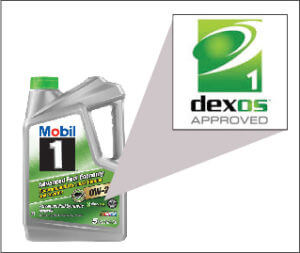
GM requires DEXOS oil in all newer engines
DEXOS oil contains a higher percentage of anti-wear additives that are designed to prevent timing chain and high pressure fuel pump and camshaft wear. In addition, the oil life monitors are programmed to determine when to change your oil based on using the proper oil. If you don’t use DEXOS or use the wrong viscosity, the oil life monitors won’t provide accurate oil change information.
Improper oil viscosity can also have a serious impact on timing chain tensioner operation, variable valve timing solenoids and actuators, and direct injection fuel pump wear. In fact, using a motor oil viscosity other than the factory recommended oil can result in a check engine light, sludge buildup and catastrophic engine damage.
Timing chain damage due to extended oil changes
Most owners aren’t aware that carmakers list driving styles as the main determining factor in calculating oil change intervals. It’s not uncommon for self proclaimed experts to state that a synthetic oil can easily run for 10,000 to 15,000 miles. Even car dealers tell customer to use those kinds of oil change intervals. But if you read your owner’s manual, you’ll discover that “severe” use requires far more frequent oil changes.
What is severe use?
• Cold starts and short trips. Starting your car in cold weather and driving it for short distances dramatically reduces motor oil life. The rich fuel mixtures cause excess gasoline and water to enter the crankcase where it dilutes the oil and forms sludge. That rapidly depletes the anti-corrosion additives in the oil.
• Stop and go driving. This type of driving cause oil shear and thermal breakdown that dramatically shortens the life of motor oil—even synthetic.
• Heavy loads. Added stress accelerates oil shear
Most U.S. urban drivers fall into the severe driving category but use normal driving oil change schedules, causing the oil to wear out sooner. In fact, a carmaker that recommends changing oil every 10,000 miles for normal driving will also recommend 5,000 mile oil change intervals for severe driving.
Another factor that contributes to accelerated timing wear is owner failure to check their oil level on a regular basis. Here’s why: If your driving falls into the “normal” category and you use a 10,000 mile oil change interval but don’t check your oil regularly and add more to bring it back to spec, you may be running your engine when it’s low on oil. If your engine requires the typical four to five quarts and your engine burns a quart of oil every 5,000 miles, you’re wearing out your oil 50% faster. So your oil additives are severely deplete sometime after the first 5,000 miles.
©, 2017 Rick Muscoplat
Posted on by Rick Muscoplat
